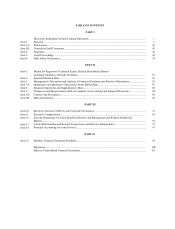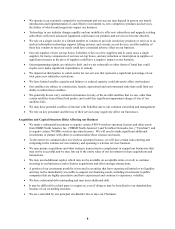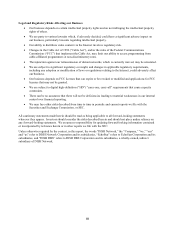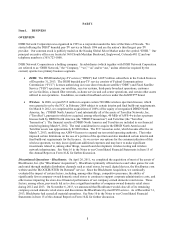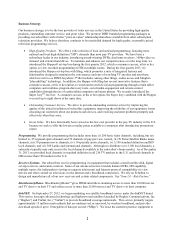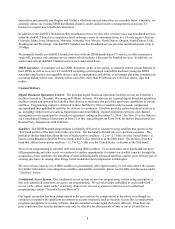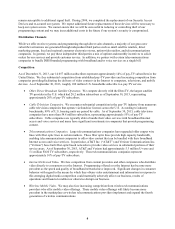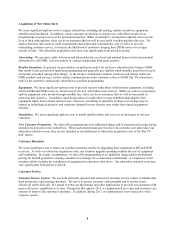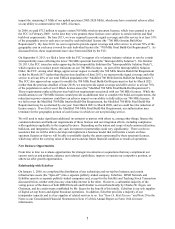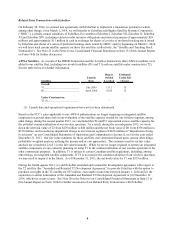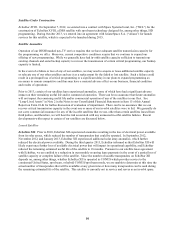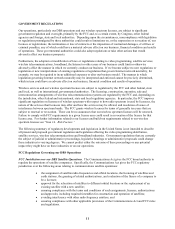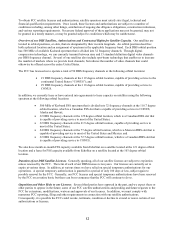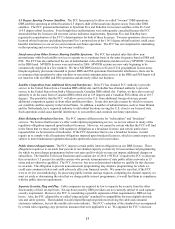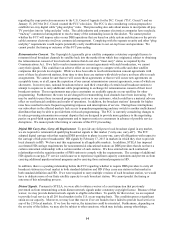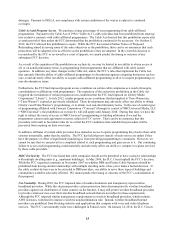Dish Network 2013 Annual Report Download - page 16
Download and view the complete annual report
Please find page 16 of the 2013 Dish Network annual report below. You can navigate through the pages in the report by either clicking on the pages listed below, or by using the keyword search tool below to find specific information within the annual report.6
6
Installation and Other In-Home Service Operations. High-quality installations, upgrades, and in-home repairs are
critical to providing good customer service. Such in-home service is performed by both DISH Network employees
and a network of independent contractors and includes, among other things, priority technical support, replacement
equipment, cabling and power surge repairs for a monthly fee. During 2011, we implemented a new in-home
appointment scheduling system.
Subscriber Management. We presently use, and depend on, CSG Systems International, Inc.’s (“CSG”) software
system for the majority of DISH Network subscriber billing and related functions. During the first quarter 2012, we
implemented a new billing system with CSG.
Wireless Spectrum
On March 2, 2012, the FCC approved the transfer of 40 MHz of AWS-4 wireless spectrum licenses held by DBSD
North America and TerreStar to us. On March 9, 2012, we completed the DBSD Transaction and the TerreStar
Transaction, pursuant to which we acquired, among other things, certain satellite assets and wireless spectrum
licenses held by DBSD North America and TerreStar. The total consideration to acquire the DBSD North America
and TerreStar assets was approximately $2.860 billion.
Our consolidated FCC applications for approval of the license transfers from DBSD North America and TerreStar
were accompanied by requests for waiver of the FCC’s Mobile Satellite Service (“MSS”) “integrated service” and
spare satellite requirements and various technical provisions. On March 21, 2012, the FCC released a Notice of
Proposed Rule Making proposing the elimination of the integrated service, spare satellite and various technical
requirements associated with the AWS-4 licenses. On December 11, 2012, the FCC approved rules that eliminated
these requirements and gave notice of its proposed modification of our AWS-4 authorizations to, among other
things, allow us to offer single-mode terrestrial terminals to customers who do not desire satellite functionality. On
February 15, 2013, the FCC issued an order, which became effective on March 7, 2013, modifying our AWS-4
licenses to expand our terrestrial operating authority. That order imposed certain limitations on the use of a portion
of this spectrum, including interference protections for other spectrum users and power and emission limits that we
presently believe could render 5 MHz of our uplink spectrum (2000-2005 MHz) effectively unusable for terrestrial
services and limit our ability to fully utilize the remaining 15 MHz of our uplink spectrum (2005-2020 MHz) for
terrestrial services. These limitations could, among other things, impact the ongoing development of technical
standards associated with our wireless business, and may have a material adverse effect on our ability to
commercialize these licenses. That order also mandated certain interim and final build-out requirements for the
licenses. By March 2017, we must provide terrestrial signal coverage and offer terrestrial service to at least 40% of
the aggregate population represented by all of the areas covered by the licenses (the “AWS-4 Interim Build-Out
Requirement”). By March 2020, we were required to provide terrestrial signal coverage and offer terrestrial service
to at least 70% of the population in each area covered by an individual license (the “AWS-4 Final Build-Out
Requirement”). On December 20, 2013, the FCC issued a further order that, among other things, extended the
AWS-4 Final Build-Out Requirement by one year to March 2021 (the “Modified AWS-4 Final Build-Out
Requirement”). If we fail to meet the AWS-4 Interim Build-Out Requirement, the Modified AWS-4 Final Build-
Out Requirement may be accelerated by one year, from March 2021 to March 2020. If we fail to meet the Modified
AWS-4 Final Build-Out Requirement, our terrestrial authorization for each license area in which we fail to meet the
requirement may terminate.
The FCC’s December 20, 2013 order also conditionally waived certain FCC rules for our AWS-4 spectrum licenses
to allow us to repurpose 20 MHz of our uplink spectrum (2000-2020 MHz) for downlink (the “AWS-4 Downlink
Waiver”). The AWS-4 Downlink Waiver and the Modified AWS-4 Final Build-Out Requirement are conditioned
upon us bidding at least a net clearing price equal to the aggregate reserve price of $1.56 billion in the auction of
wireless spectrum known as the “H Block.” The auction commenced January 22, 2014. Under the FCC’s anti-
collusion and anonymous bidding rules for this auction, we are not permitted to disclose publicly our interest level
or activity level in the auction, if any, at this time. If we fail to meet this bidding condition, or if we fail to notify the
FCC whether we intend to use our uplink spectrum for downlink by June 20, 2016, the AWS-4 Downlink Waiver
will terminate, and the Modified AWS-4 Final Build-Out Requirement will revert back to the AWS-4 Final Build-
Out Requirement. The FCC has adopted rules for the H Block spectrum band that is adjacent to our AWS-4
spectrum licenses. Depending on the outcome of the standard-setting process for the H Block and our ultimate
decision regarding the AWS-4 Downlink Waiver, the rules that the FCC adopted for the H Block could further


